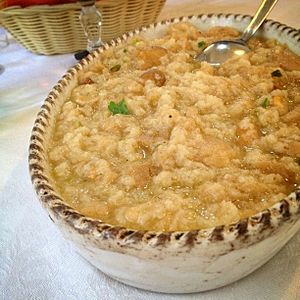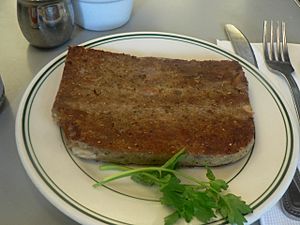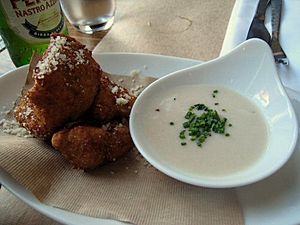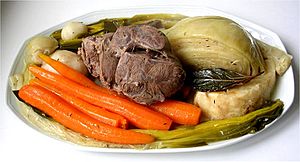Peasant foods facts for kids
Peasant foods are simple dishes made from ingredients that were easy to find and didn't cost much money. They were traditionally eaten by peasants, who were often farmers or people living in the countryside with limited resources.
For a long time, these foods were sometimes looked down upon. This was because they often used parts of animals or plants that richer people didn't want. For example, they might use offal (like organ meats) or tougher cuts of meat. These ingredients were not as valuable as "cash crops," which were grown to sell for money.
Many peasant foods are "one-dish meals." This means they contain everything you need in a single pot, like a hearty stew or soup. They are clever ways to make a filling meal from whatever is available.
Contents
Types of Peasant Foods
Meat and Grain Dishes
These dishes often mix ground meat or meat scraps with grains. They are usually formed into a loaf, sliced, and then fried. This was a great way to make a small amount of meat go further.
- Balkenbrij
- Black pudding
- Boudin
- Goetta – a sausage made from pork or pork and beef mixed with oats.
- Groaty pudding
- Haggis – a savory Scottish dish. It contains sheep's pluck (heart, liver, and lungs) minced with onion, oatmeal, and spices. It is traditionally cooked inside a sheep's stomach.
- Knipp
- Livermush
- Lorne sausage
- Meatloaf
- Scrapple – pig scraps, cornmeal, and other flours mixed and fried.
- Slátur
Pasta Dishes
Pasta was a simple and filling food, especially in Italy. These dishes often used basic ingredients that were easy to grow or find.
- Pasta con i peperoni cruschi – an Italian pasta dish from Basilicata. It is known as a true example of "cucina povera," meaning "poor cooking."
- Pasta mollicata – another Italian pasta dish from Southern Italy. It is often called a "poor man's dish."
- Testaroli
Simple Sauces
Sauces could add flavor to simple meals. Some, like agliata, were used by everyone, from peasants to the wealthy.
- Agliata – a garlic sauce from Italian cuisine. It was a common peasant food but also enjoyed by richer people.
Hearty Soups and Stews
Soups and stews were perfect for peasant cooking. You could throw in whatever ingredients were available, making a warm and filling meal in one pot.
- Acquacotta – an Italian soup from ancient times. It uses water, stale bread, onion, tomato, and olive oil. It also includes any vegetables or leftovers available.
- Cassoulet – a French stew with beans, meat, and vegetables. It started in the countryside of Southwest France and is now a famous French dish.
- Cawl – a Welsh broth or soup.
- Cholent – a traditional Jewish Sabbath stew. It is cooked slowly for a long time.
- Chupe – a type of stew from South America. It usually has chicken, red meat, lamb, or beef tripe and other organ meats.
- Duckefett – a German sauce.
- Dinuguan – a Filipino pork blood stew flavored with vinegar.
- Feijoada – originally a Portuguese stew with beans and meat. It is also a Brazilian dish. In Brazil, it was first made by slaves using leftover ingredients from their masters' houses.
- Gazpacho – a cold, tomato-based vegetable soup. It comes from the southern Spanish region of Andalusia.
- Minestrone – a "meal in one pot" from ancient Italy. It is still a basic part of Italian cooking today.
- Mulligan stew – a stew often made by workers who traveled from place to place.
- Mujaddara – an Arabian dish made of lentils, rice, grains, and onions.
- Pea soup – a common thick soup made from dried peas. Peas were a very common food in Europe. It is still widely eaten there and in French Canada.
- Pot-au-feu – a classic French stew with oxtail, marrow, and vegetables, sometimes with sausage.
- Pottage – a basic stew made from boiling vegetables, grains, and whatever was available. People have been making it in the British Isles since ancient times.
- Ratatouille – a French stewed vegetable dish.
- Shchi – a traditional Russian soup. It is made from cabbage, meat, mushrooms, flour, and sour cream. It is usually eaten with rye bread.
- Scouse (food) – a stew from Liverpool, England. The people from Liverpool are even called "scousers" because of this dish!
- Zatiruha – an Eastern European soup.
Other Traditional Peasant Foods
Many other foods were important for peasants. They were often simple, filling, and made from ingredients that were easy to get or store.
- Baked beans – a simple stewed bean dish.
- Barbacoa – a way of slow cooking, often an animal's head. It was an early form of what we now call barbecue.
- Bulgur wheat – often cooked with vegetables or meat.
- Broken rice – this rice is often cheaper than whole grains and cooks faster.
- Bubble and squeak – a simple British dish. It is made by cooking and frying leftover potatoes and cabbage together.
- Ragi balls – made from ragi flour boiled with water. The balls are formed and eaten with vegetable gravy.
- Greens – like dandelion and collard greens. These were often gathered from the wild.
- Head cheese – made by boiling down the cleaned head of an animal to make a broth. It is still made today.
- Hominy – a type of corn specially prepared to be more nutritious.
- Horsebread – a low-cost European bread that was a last resort for very poor people.
- Katemeshi – a Japanese peasant food. It has rice, barley, millet, and chopped daikon radish.
- Lampredotto – a dish or sandwich from Florence, Italy. It is made from a cow's fourth stomach.
- Polenta – a porridge made with corn. Landowners would often leave corn for Italian farmers so they could sell all the wheat crops. It is still a popular food today.
- Pumpernickel – a traditional dark rye bread from Germany. It is made with a long, slow steam-baking process.
- Red beans and rice – a Louisiana Creole dish. It is made with red beans, vegetables, spices, and leftover pork bones cooked slowly. It is served over rice. This was common on Mondays when working women were busy hand-washing clothes.
- Salami – a sausage that lasts a long time. It was used to add meat to a diet that didn't have much.
- Soul food – developed by African-American slaves and servants. It mainly used ingredients that their employers or slaveholders didn't want and gave away.
- Succotash – a mix of corn and beans.
- Taco – foods placed on native tortillas in the Americas.
Images for kids
-
A slice of pumpernickel bread.








